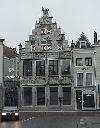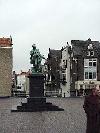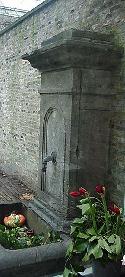Click to enlarge

Golden Ox House in Green Street |
This richly decorated house, deserving its name for obvious reasons, was the butchers' guild-house. The tiny shop next to it still is a 'slagerij' or butcher's, though apparently not of Dutch stock. The bridge I was standing on to take the picture is spanning the narrow end of the Old Harbour. To the left, where a car is just rounding the corner, a monument stands to the remembrance of two brothers of the Dordrechtian noble family De Witt, who in the summer of 1672 were both killed and quartered in The Hague in an orangist street-riot.
The younger of the two, Johan de Witt, was Councillor of State of the republic of Holland, and as such a formidable opponent to the aspirations to royal power of the young Prince of Orange, William III, whom, by marriage, the English received as their king William III.
If you were ever wondering why Dutch sports' fans are painting their faces orange, or wear ludicrous hats of that dye at all, in spite of the national colours of the Netherlands being red-white-blue, now you have the answer!
From Dordrecht sprang many painters. Some great names still ring today, like Cuyp's, but there've been many others who climbed to fame. The statue on the left is dedicated to the Dordrechtian painter and sculptor Ary Scheffer, who
|

View of Old Harbour's Close with statue of local painter, Ary Scheffer, 1795-1858 |
studied in Paris and joined the Romantic movement of the first half of the 19th century.
Two earlier local celebrities have been the Van Strij brothers, Abraham (1753-1826), who with his brother Jacob (1756-1815), enlighted the walls of contemporary patrician houses with paintings, drawings, wallpaper and decorative hangings.
They took their examples from the great Dutch masters of the 17th century, Albert Cuyp, Pieter de Hooch, Paulus Potter, going even to the point of literal pictoral 'quotes', but their style was more conventional, giving scrupulous attention to detail as the taste of the time, and their patrons with it, required. |
Old well
Dordts Museum
inner courtyard
 |
They personally favoured different subjects, however, as Abraham shows a preference for snug interiors, while Jacob is dealing with landscapes, or riverscapes for that matter, provided with the odd ruminating cow.
We ended our cultural tour in the Dordts Museum, where they have a decent tea room giving on a spacious garden and where an exposition of the brothers' work had just opened up, and afterwards we had a nice supper at "De Dulle Griet", Nieuwstraat 25, a little restaurant run by two women and named after a grotesque character in a Bruegelian painting.
|

